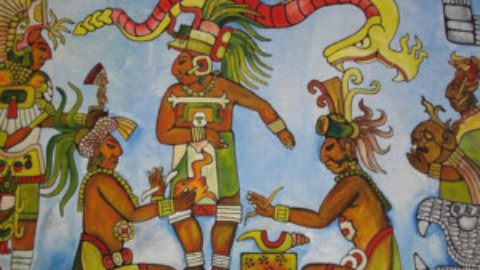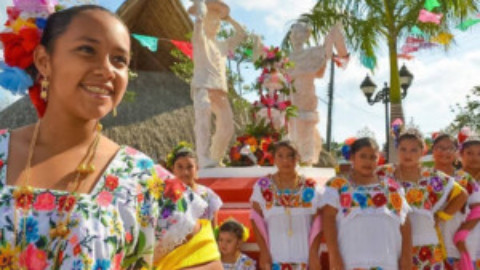Mexican Currency
The bills that will go down in history and the ones yet to come – Part 2
The most ancient form of trade among the Mexican peoples of earlier times was the use of beads, stones, cacao beans and grains of gold as “currencies” of different shapes and seizes, and the Mayans also used copper. Since those early times we have come a long way, worldwide.
Mexico’s culture is so rich and vast that, in modern times, those who had to choose what the bills would depict must have had a difficult time deciding. And while we physically pay for goods purchased, there is an inadvertent exchange of Mexico’s cultural wealth we often overlook.
While aside from the new 500- peso bill other new bills have yet to be printed, Banco de Mexico (or Banxico, Mexico’s central bank and monetary authority) has shared what these new bills will include.
The NEW fifty-peso bill …
This new note will be issued in 2022. On the right, an unofficial version of what the new 50- peso bill could look like. It 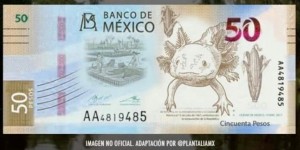 will include Tenochtitlan, the capital of the Aztec empire, destroyed in 1521 by the Spaniards. This now is Mexico City. Legend has it that through a priest, god Huitzilopochtli communicated to a wandering tribe they should look for a sign of an eagle (devouring a snake) standing on a cactus. This site would become “the center of the world”, their capital : Mexico-Tenochtitlan. That sign is the iconic center of the Mexican flag. The axolotl (from the Nahuatl, “water-dog”, or walking fish) is an ancestral amphibian that lives all its life underwater and has the ability to regenerate lost body parts. This unique and very peculiar salamander is considered a critically endangered species. The maize: While Aztecs believed that it was a gift from Quetzalcóatl (Kukulkán for the Maya), in the famous book Popol Vuh of the Quiche Maya on the creation of men, told us that the gods created men’s flesh from the batter of the yellow and white corn. Maize has been the main staple for Mexicans for the preparation of tortillas (tlaxcalli in Nahuatl and waaj in Maya) and other foods. Xochimilco, “the land seeded with flowers”, UNESCO’s World Heritage Site, will also be depicted. Famous for its chinampas, or “floating gardens”, artificial islands where crops are grown and many are nurseries for Mexico’s famous poinsettias. The ecological reserve of Xochimilco is known worldwide for the rides on the traditional trajineras, pontoon-like boats adorned with colorful flowers. While riding through the canals on a trajinera, you can be entertained by mariachis and relish with typical Mexican food.
will include Tenochtitlan, the capital of the Aztec empire, destroyed in 1521 by the Spaniards. This now is Mexico City. Legend has it that through a priest, god Huitzilopochtli communicated to a wandering tribe they should look for a sign of an eagle (devouring a snake) standing on a cactus. This site would become “the center of the world”, their capital : Mexico-Tenochtitlan. That sign is the iconic center of the Mexican flag. The axolotl (from the Nahuatl, “water-dog”, or walking fish) is an ancestral amphibian that lives all its life underwater and has the ability to regenerate lost body parts. This unique and very peculiar salamander is considered a critically endangered species. The maize: While Aztecs believed that it was a gift from Quetzalcóatl (Kukulkán for the Maya), in the famous book Popol Vuh of the Quiche Maya on the creation of men, told us that the gods created men’s flesh from the batter of the yellow and white corn. Maize has been the main staple for Mexicans for the preparation of tortillas (tlaxcalli in Nahuatl and waaj in Maya) and other foods. Xochimilco, “the land seeded with flowers”, UNESCO’s World Heritage Site, will also be depicted. Famous for its chinampas, or “floating gardens”, artificial islands where crops are grown and many are nurseries for Mexico’s famous poinsettias. The ecological reserve of Xochimilco is known worldwide for the rides on the traditional trajineras, pontoon-like boats adorned with colorful flowers. While riding through the canals on a trajinera, you can be entertained by mariachis and relish with typical Mexican food.
The 100 peso bill …
There are currently two 100-peso bills in use. The first one, on the front, bears an image of Netzahualcoyotl, the ruler 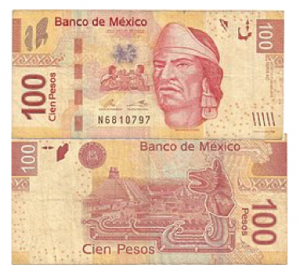 (tlatoani) of Texcoco, also a military and poet. In fine print, a stanza of his most famous poem: “I love the song of the mockingbird, bird of four hundred voices; I love the color of the jade stone and the intoxicating scent of flowers, but more than all, I love my brother: man.” On the back a depiction of Templo Mayor, the central plaza of Mexico-Tenochtitlan, the Aztec
(tlatoani) of Texcoco, also a military and poet. In fine print, a stanza of his most famous poem: “I love the song of the mockingbird, bird of four hundred voices; I love the color of the jade stone and the intoxicating scent of flowers, but more than all, I love my brother: man.” On the back a depiction of Templo Mayor, the central plaza of Mexico-Tenochtitlan, the Aztec
capital city and an Aztec image of a coyote as Netzahualcoyotl’s name in Nahuatl means “fasting coyote.”
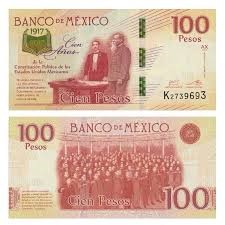 Considered a collectors’ item, the second 100-peso note was printed in 2017 to commemorate 100 years of the Constitution of the United Mexican States. On the front: Venustiano Carranza, First Leader of the Constitutionalist Army and Luis Manuel Rojas, president of the Constituent Congress, standing during the formal adjournment of the session. On the back, Congress Representatives swearing to observe the Mexican Constitution.
Considered a collectors’ item, the second 100-peso note was printed in 2017 to commemorate 100 years of the Constitution of the United Mexican States. On the front: Venustiano Carranza, First Leader of the Constitutionalist Army and Luis Manuel Rojas, president of the Constituent Congress, standing during the formal adjournment of the session. On the back, Congress Representatives swearing to observe the Mexican Constitution.
The NEW hundred-peso bill …
To be issued in 2021. Its front will bear the likeness of someone you are familiar with and who appears in the current 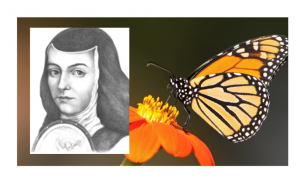 200-pesos bill: Sor Juana Ines de la Cruz, also known as Juana de Asbaje, a 17th. century nun considered the most important poet and writer in Mexican and Latin-American literature. The back will have pines, oaks and the beautiful monarch butterfly that migrates on every year October, from Canada and the US, to the sanctuary in the State of Michoacán to breed and then fly back in the summer. Their life span is four to five weeks. It has been reported their
200-pesos bill: Sor Juana Ines de la Cruz, also known as Juana de Asbaje, a 17th. century nun considered the most important poet and writer in Mexican and Latin-American literature. The back will have pines, oaks and the beautiful monarch butterfly that migrates on every year October, from Canada and the US, to the sanctuary in the State of Michoacán to breed and then fly back in the summer. Their life span is four to five weeks. It has been reported their
daily flight is 120 kilometers (74miles) and is considered one of the longest and largest migrations in the world. While in their sanctuary they gift us with one of the most spectacular sights nature can offer.
The 200-peso bill
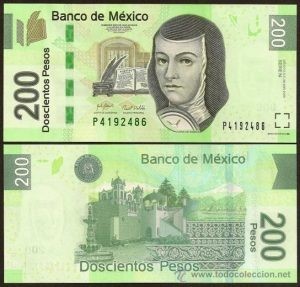 Born around 1651, Sor Juana Ines de la Cruz was a nun and an intellectually gifted woman, a prolific writer and poet, immersed in theology, science, history, music and literature, and is considered as Mexico’s first feminist. Legend has is that when she was a young girl she read the 3000 books in her grandfather’s library. In fine print, on the front, a very famous piece of one of her works (“Philosophic Satire”): “You foolish men who lay the guilt on women, not seeing you are the cause of the very thing you blame…”
Born around 1651, Sor Juana Ines de la Cruz was a nun and an intellectually gifted woman, a prolific writer and poet, immersed in theology, science, history, music and literature, and is considered as Mexico’s first feminist. Legend has is that when she was a young girl she read the 3000 books in her grandfather’s library. In fine print, on the front, a very famous piece of one of her works (“Philosophic Satire”): “You foolish men who lay the guilt on women, not seeing you are the cause of the very thing you blame…”
On the back, the Panoayan Hacienda in the State of Mexico, where Sor Juana lived, and as backdrop the famous volcanoes Popocatepetl and Iztaccihuatl.
The NEW two hundred-peso bill …
We will see this note in 2019. The front will have two very important figures of the Mexican Independence, Miguel 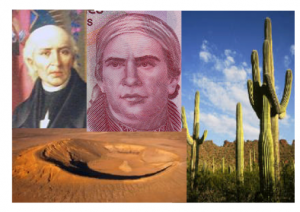 Hidalgo and José María Morelos. Both insurgent priests, along with others, plotted to overthrow the Spanish rulers. On the back drawings of the Royal Eagle, an iconic symbol in the Mexican flag and of the Mexicans, and the saguaro, a large cactus endemic to the Sonoran Desert. Also from the State of Sonora an illustration of the UNESCO’s Biosphere Reserve landscape depicting the dormant volcano El Pinacate and Gran Desierto de Altar.
Hidalgo and José María Morelos. Both insurgent priests, along with others, plotted to overthrow the Spanish rulers. On the back drawings of the Royal Eagle, an iconic symbol in the Mexican flag and of the Mexicans, and the saguaro, a large cactus endemic to the Sonoran Desert. Also from the State of Sonora an illustration of the UNESCO’s Biosphere Reserve landscape depicting the dormant volcano El Pinacate and Gran Desierto de Altar.
The 500-peso bill…
As of August 2018 we have been gradually saying goodbye to this bill portraying the most iconic couple of Mexican 20th Centrury art: Diego Rivera who as a young man fought in the Revolution and created art for 50 years. Most of his masterpieces have a social content and his fresco murals can be found in public buildings in Mexico, even in the US. Most of his artwork was controversial, revolutionary, and critical. One of his paintings, “Nude with Calla Lilies”, appears on the front of this note and the small print reads: “It has been said that the Revolution does not need art, but that art does needs the Revolution. That is not true. The Revolution does need revolutionary art” His third marriage was to Frida Kahlo. He was 46, she was 21. At 6 she was affected by polio and later in life was
fatally wounded by a streetcar. Before she became a painter, she studied medicine. Her colorful folkloric and popular art was greatly influenced by Rivera. Of her 143 paintings, 55 are self-portraits showing painful aspects of her life, mostly while she was bedridden. She is seen along her painting “The Love Embrace of the Universe, the Earth (Mexico), Me, Diego and Señor Xolotl”, a self-portrait celebrating the Riveras’ marriage.
The NEW five hundred-peso bill …
This new bill has been in effect since last August 27. You must be very careful not to mistake them with the 20-peso bills 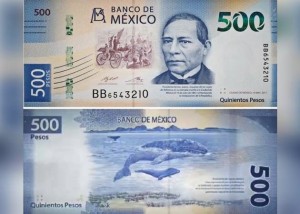 as both are in blue hues and the face of President Benito Juarez appears on the front.
as both are in blue hues and the face of President Benito Juarez appears on the front.
The center of the bill illustrates what the fine print reads: “President Benito Juarez, promoter of the Laws of Reform, in his triumphal entrance to Mexico City on July 18, 1867, symbolizing the Restoration of the Republic.” On the back, the ecosystem represented by an image of the coasts, seas and islands along a grey whale and her calf in the Biosphere Reserve of El Vizcaino, in the State of Baja California Sur, acknowledged by UNESCO as World Heritage Site.
The 1,000-peso bill…
 This is a bill that is not seen as often as the others and it is currently the highest denomination. Its main colors are pink and violet. On the front Miguel Hidalgo y Costilla insurgent, hero of the Independence and “Father of the Nation”. He called the people to arms against the Spaniards while he tolled the bell – illustrated in the middle of the bill- of the church in the town of Dolores. The small print reads: “Without country or freedom we shall always be at a great distance from true happiness”. On the back, the beautiful University of Guanajuato built in the 18th century. It has been recognized for its collaboration to education, science, art and culture not only in Guanajuato but
This is a bill that is not seen as often as the others and it is currently the highest denomination. Its main colors are pink and violet. On the front Miguel Hidalgo y Costilla insurgent, hero of the Independence and “Father of the Nation”. He called the people to arms against the Spaniards while he tolled the bell – illustrated in the middle of the bill- of the church in the town of Dolores. The small print reads: “Without country or freedom we shall always be at a great distance from true happiness”. On the back, the beautiful University of Guanajuato built in the 18th century. It has been recognized for its collaboration to education, science, art and culture not only in Guanajuato but
the country, and for its international prestige. On the bottom right, an image of Ehecatl, the Aztec god of wind.
The NEW one thousand-peso bill …
We will possibly see this bill on the second half of 2020. The bill will refer to the Mexican Revolution with Francisco I. 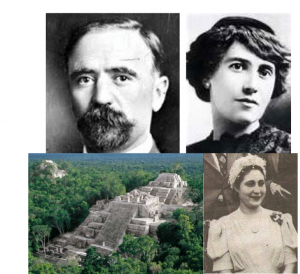 Madero Carmen Serdán and Hermilia Galindo on the front. In 1910, Madero led the rebellion against dictator Porfirio Diaz and later during his presidency, he established the suffrage and forbid reelection. Both Serdán as well as Galindo were unrelenting supporters of Madero’s anti-reelectionism and inciting people to join the fight. While Serdán was a woman-of-arms Galindo laid the foundations for feminist ideas, sexual education and attacked the church. In Merida she promoted women’s participation in politics. On the back, the beautiful ancient and powerful Mayan city of Calakmul, in Campeche, the “City of the Two Adjacent Pyramids”, a Natural and Cultural Heritage Site as per UNESCO. This was the kingdom of the serpent or kaan Its biosphere will also be represented by jaguars, the sacred ceiba tree and zapote (sapodilla)
Madero Carmen Serdán and Hermilia Galindo on the front. In 1910, Madero led the rebellion against dictator Porfirio Diaz and later during his presidency, he established the suffrage and forbid reelection. Both Serdán as well as Galindo were unrelenting supporters of Madero’s anti-reelectionism and inciting people to join the fight. While Serdán was a woman-of-arms Galindo laid the foundations for feminist ideas, sexual education and attacked the church. In Merida she promoted women’s participation in politics. On the back, the beautiful ancient and powerful Mayan city of Calakmul, in Campeche, the “City of the Two Adjacent Pyramids”, a Natural and Cultural Heritage Site as per UNESCO. This was the kingdom of the serpent or kaan Its biosphere will also be represented by jaguars, the sacred ceiba tree and zapote (sapodilla)
There is one last bill that only if Banxico deems it necessary, could be printed and only in small batches. . .
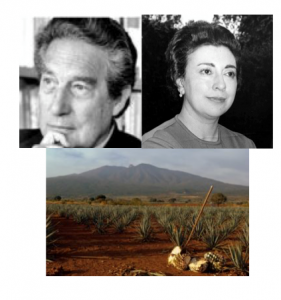 This possible bank note is the 2,000-peso bill. The main theme will be contemporary Mexico represented by writers Octavio Paz and Rosario Castellanos. Paz was a Mexican poet, writer, translator, essayist and diplomat, who won a Nobel Prize in Literature. He is considered among the 20th century’s greatest Spanish-speaking writers. Castellanos, the most important female poet of the 20th century. She devoted her life to the indigenous peoples and women in her country. Her poetry expressed her own life and how the female spirit must adapt to a world of men. She was ambassador of Mexico in Israel. On the back an agave landscape. The agave is the plant from which the mezcal and tequila are made. It could also include an image of the lesser long-nosed bat, responsible of pollinating different species of agave plants.
This possible bank note is the 2,000-peso bill. The main theme will be contemporary Mexico represented by writers Octavio Paz and Rosario Castellanos. Paz was a Mexican poet, writer, translator, essayist and diplomat, who won a Nobel Prize in Literature. He is considered among the 20th century’s greatest Spanish-speaking writers. Castellanos, the most important female poet of the 20th century. She devoted her life to the indigenous peoples and women in her country. Her poetry expressed her own life and how the female spirit must adapt to a world of men. She was ambassador of Mexico in Israel. On the back an agave landscape. The agave is the plant from which the mezcal and tequila are made. It could also include an image of the lesser long-nosed bat, responsible of pollinating different species of agave plants.
Through the time machine we handle in our every day trade, we have visited a few of Mexico’s ancient cities, its architectural jewels; we have learned about heroes and contemporary culture, and reviewed some of its many amazing ecosystems. Mexico has so much more to offer. Exploring and learning we will always find that Mexico has much more to offer.
Los billetes que pasaran a la historia y los que están por llegar – parte 2
La forma más antigua de intercambio comercial entre los pueblos mexicanos de antaño era a través del uso de cuentas, granos de cacao y granos oro como “divisas” de distintas formas y tamaños. Los mayas también utilizaban el cobre. Desde esas esos remotos tiempos hemos hecho un largo recorrido, mundialmente.
La cultura mexicana es tan rica y vasta que, en la actualidad, es posible que quienes se dieron a la tarea de elegir lo que se representaría en los billetes pasaron ratos difíciles tomando la decisión. Y en tanto pagamos físicamente por los bienes adquiridos, sin advertirlo existe un intercambio de la riqueza cultural de México que con frecuencia pasamos por alto.
Aparte del billete de 500 pesos aún faltan por imprimirse otros billetes; sin embargo, Banco de México (o Banxico, el banco central y autoridad monetaria de México) ha compartido lo que incluirán los nuevos billetes.
El NUEVO billete de cincuenta pesos …
 Este nuevo billete estará impreso en el año 2022. A la derecha, una versión no oficial de cómo podría lucir el billete de 50. Incluirá a Tenochtitlan, la capital del imperio azteca destruida en 1521 por los españoles. Hoy día, esta es la Ciudad de México. Cuenta la leyenda que a través de un sacerdote el dios Huitzilopochtli comunicó a una tribu errante que deberían buscar la señal de un águila (devorando una serpiente) posada sobre un nopal. Este sitio se convertiría en el “centro del mundo, su capital: México-Tenochtitlan.
Este nuevo billete estará impreso en el año 2022. A la derecha, una versión no oficial de cómo podría lucir el billete de 50. Incluirá a Tenochtitlan, la capital del imperio azteca destruida en 1521 por los españoles. Hoy día, esta es la Ciudad de México. Cuenta la leyenda que a través de un sacerdote el dios Huitzilopochtli comunicó a una tribu errante que deberían buscar la señal de un águila (devorando una serpiente) posada sobre un nopal. Este sitio se convertiría en el “centro del mundo, su capital: México-Tenochtitlan.
Esa señal es la figura simbólica que aparece en la bandera mexicana. El ajolote (“perro de agua” en náhuatl, o pez que camina) es un ancestral anfibio que toda su vida vive bajo el agua y tiene la habilidad de regenerar las partes que llega a perder de s cuerpo. Esta singular y peculiar salamandra está considerada como especie en peligro crítico de extinción. El maíz: los aztecas creían que el maíz era un regalo del Quetzalcóatl (Kukulkán para los mayas) mientras que el famoso libro Popol Vuh de los maya quiché respecto a la creación de los hombres nos decía que de la masa del maíz blanco y amarillo los dioses crearon la carne del hombre. El maíz ha sido el alimento básico de los mexicanos para preparar las tortillas (tlaxcalli en náhuatl y waaj en maya) así como otros alimentos. Xochimilco, “la tierra sembrada con flores”, Patrimonio Mundial de la UNESCO, también aparecerá representado. Famoso por sus chinampas, o “jardines flotantes”, islas artificiales de cultivo y muchas son viveros de las famosas flores de Nochebuena mexicanas. La reserva ecológica de Xochimilco se conoce mundialmente por los paseos en las típicas trajineras, embarcaciones similares a pontones adornadas con coloridas flores. Mientras pasea por los canales en la trajinera, podrá ser amenizado por mariachis y disfrutar la comida mexicana.
El billete de 100 pesos …
En la actualidad hay dos billetes de 100 pesos en circulación. 
El primero al frente reviste la imagen de Netzahualcóyotl, gobernante de (tlatoani) Texcoco; también fue militar y poeta. En el texto microimpreso se una estrofa de su poema más famoso: “Amo el canto del cenzontle, pájaro de cuatrocientas voces; amo el color del jade y el enervante perfume de las flores, pero amo más a mi hermano: el hombre”. Al reverso, una imagen del Templo Mayor, la plaza central de México-Tenochtitlan, capital de los aztecas y una imagen azteca de un coyote pues el nombre de Netzahualcóyotl en nahua significa “coyote que ayuna”.
 El segundo billete de 100 pesos, considerado artículo de colección, fue impreso en el 2017 para conmemorar los 100 años de la Constitución de los Estados Unidos Mexicanos. Al frente: Venustiano Carranza Primer Jefe del Ejército Constitucionalista y Luis Manuel Rojas, presidente del Congreso Constituyente, de pie durante el cierre formal de la sesión. Al reverso, los diputados del Congreso protestando cumplir la Constitución mexicana.
El segundo billete de 100 pesos, considerado artículo de colección, fue impreso en el 2017 para conmemorar los 100 años de la Constitución de los Estados Unidos Mexicanos. Al frente: Venustiano Carranza Primer Jefe del Ejército Constitucionalista y Luis Manuel Rojas, presidente del Congreso Constituyente, de pie durante el cierre formal de la sesión. Al reverso, los diputados del Congreso protestando cumplir la Constitución mexicana.
El NUEVO billete de cien pesos …
Se emitirá en el año 2021. Al frente aparecerá la imagen de alguien que ya conocen y que aparece en el billete de 200  actual: Sor Juana Inés de la Cruz, también conocida como Juana de Asbaje, una monja del siglo 17 considerada la poetiza y escritora más importante en la literatura mexicana y latinoamericana. El reverso mostrará pinos, encinos y a la bella mariposa monarca que migra desde Canadá y los EUA cada año en Octubre hacia su santuario en el Estado de Michoacán, para reproducirse y luego volar de regreso en el verano. Su ciclo de vida es de cuatro a cinco semanas. Se tiene información que diariamente vuelan 120 kilómetros (74 millas) y está considerada una de las migraciones más grandes y largas en el mundo. Mientras se encuentran en su santuario, nos regalan uno de los espectáculos más espectaculares que la naturaleza puede ofrecer.
actual: Sor Juana Inés de la Cruz, también conocida como Juana de Asbaje, una monja del siglo 17 considerada la poetiza y escritora más importante en la literatura mexicana y latinoamericana. El reverso mostrará pinos, encinos y a la bella mariposa monarca que migra desde Canadá y los EUA cada año en Octubre hacia su santuario en el Estado de Michoacán, para reproducirse y luego volar de regreso en el verano. Su ciclo de vida es de cuatro a cinco semanas. Se tiene información que diariamente vuelan 120 kilómetros (74 millas) y está considerada una de las migraciones más grandes y largas en el mundo. Mientras se encuentran en su santuario, nos regalan uno de los espectáculos más espectaculares que la naturaleza puede ofrecer.
El billete de 200 pesos
 Nacida cerca del año 1651, Sor Juana Inés de la Cruz fue monja y una mujer intelectualmente talentosa, escritora prolífica y poeta, inmersa en la teología, las ciencias, historia, música y literatura, y es considerada la primera feminista de México. Cuenta la leyenda que cuando era jovencita leyó los 3000 libros en la biblioteca de su abuelo. En el texto microimpreso, una estrofa de una de sus obras más famosas (“Sátira Filosófica”): “Hombres necios que acusáis a la mujer sin razón, sin ver que sois la ocasión de lo mismo que culpáis”. En el reverso, la Hacienda de Panoayan, Estado de México donde vivió Sor Juana, y al fondo, los famosos volcanes Popocatepetl and Iztaccihuatl.
Nacida cerca del año 1651, Sor Juana Inés de la Cruz fue monja y una mujer intelectualmente talentosa, escritora prolífica y poeta, inmersa en la teología, las ciencias, historia, música y literatura, y es considerada la primera feminista de México. Cuenta la leyenda que cuando era jovencita leyó los 3000 libros en la biblioteca de su abuelo. En el texto microimpreso, una estrofa de una de sus obras más famosas (“Sátira Filosófica”): “Hombres necios que acusáis a la mujer sin razón, sin ver que sois la ocasión de lo mismo que culpáis”. En el reverso, la Hacienda de Panoayan, Estado de México donde vivió Sor Juana, y al fondo, los famosos volcanes Popocatepetl and Iztaccihuatl.
El NUEVO billete de doscientos …
Este saldrá en el año 2019. Al frente, dos personajes muy importantes de la Independencia mexicana; Miguel Hidalgo y  José maría Morelos. Ambos curas insurgentes, junto a otros, conspiraron para derrocar a los gobernantes españoles. Al reverso: ilustraciones de el Águila Real, símbolo emblemático de la bandera mexicana y de los mexicanos; y el saguaro, un gran cactus endémico del Desierto de Sonora. También de Sonora, una ilustración de la Reserva de la Biósfera de El Pinacate, el volcán inactivo, y del Gran Desierto de Altar conforme a UNESCO.
José maría Morelos. Ambos curas insurgentes, junto a otros, conspiraron para derrocar a los gobernantes españoles. Al reverso: ilustraciones de el Águila Real, símbolo emblemático de la bandera mexicana y de los mexicanos; y el saguaro, un gran cactus endémico del Desierto de Sonora. También de Sonora, una ilustración de la Reserva de la Biósfera de El Pinacate, el volcán inactivo, y del Gran Desierto de Altar conforme a UNESCO.
El billete de 500 pesos…
![]() A partir de Agosto 2018, de manera gradual nos despedimos de este billete en el cual aparece la pareja más emblemática del arte mexicano del siglo 20: Diego Rivera, que de joven luchó en la Revolución, y creara arte durante 50 años. La mayoría de sus obras maestras tienen un contenido social y sus murales pueden encontrarse en edificios públicos en México, incluso en los EUA. Gran parte de su arte fue polémico, revolucionario y crítico. Una de sus pinturas, “Desnudo con Alcatraces” aparece al frente de este billete y en el texto se lee: “Se ha dicho que la Revolución no necesita del arte, pero que el arte necesita de la Revolución. Eso no es cierto. La Revolución necesita del arte revolucionario”. En su tercer matrimonio casó con Frida Kahlo. Él tenía 46 años de edad; ella, 21. A los 6 años se vio
A partir de Agosto 2018, de manera gradual nos despedimos de este billete en el cual aparece la pareja más emblemática del arte mexicano del siglo 20: Diego Rivera, que de joven luchó en la Revolución, y creara arte durante 50 años. La mayoría de sus obras maestras tienen un contenido social y sus murales pueden encontrarse en edificios públicos en México, incluso en los EUA. Gran parte de su arte fue polémico, revolucionario y crítico. Una de sus pinturas, “Desnudo con Alcatraces” aparece al frente de este billete y en el texto se lee: “Se ha dicho que la Revolución no necesita del arte, pero que el arte necesita de la Revolución. Eso no es cierto. La Revolución necesita del arte revolucionario”. En su tercer matrimonio casó con Frida Kahlo. Él tenía 46 años de edad; ella, 21. A los 6 años se vio
afectada por la polio y años más tarde fue fatídicamente lesionada por un tranvía. Antes de convertirse en pintora, estudió medicina. Rivera tuvo una gran influencia en su colorido arte folclórico y popular. De sus 143 obras, 55 son autorretratos que muestran dolorosos aspectos de su vida; principalmente cuando estuvo postrada en cama. Se le puede ver junto a su obra “El Abrazo de Amor del Universo. La Tierra (México) Yo, Diego y el Señor Xolótl”, un autorretrato celebrando el matrimonio de los Rivera.
El NUEVO billete de quinientos pesos..
Este billete ha estado circulando desde el pasado Agosto 27. Deben tener cuidado de no confundirlo con el billete de 20  pesos pues ambos tienen tonos azules y el rostro presidente Benito Juárez aparece al frente.
pesos pues ambos tienen tonos azules y el rostro presidente Benito Juárez aparece al frente.
El centro del billete ilustra lo que se lee en el texto microimpreso: “Presidente Benito Juárez, promotor de las Leyes de Reforma, en su entrada triunfal a la Ciudad de México el 18 de julio de 1867l simbolizando la restauración de la República”. En el reverso, el ecosistema representado por una imagen de las costas, mares e islas junto a una ballena gris y su ballenato en la Reserva de la Biosfera de El Vizcaíno en el Estado de Baja California Sur, reconocida por UNESCO como Patrimonio de la Humanidad.
El billete de 1,000 pesos…
 Este es un billete al que no vemos tan frecuentemente como los otros y en la actualidad es la denominación más alta. Sus colores principales son rosa y violeta. Al frente aparece Miguel Hidalgo y Costilla insurgente, héroe de la Independencia y “Padre de la Nación”. Convocó al pueblo a tomar las armas contra los españoles mientras en la iglesia del poblado de Dolores tocaba la campana que ilustra el centro del billete. El micro texto dice: “Sin patria ni libertad estaremos siempre a mucha distancia de la verdadera felicidad”. En el reverso, la bella Universidad de Guanajuato, construida en el siglo 18. Ha recibido reconocimientos por su colaboración en la educación, ciencias, arte y
Este es un billete al que no vemos tan frecuentemente como los otros y en la actualidad es la denominación más alta. Sus colores principales son rosa y violeta. Al frente aparece Miguel Hidalgo y Costilla insurgente, héroe de la Independencia y “Padre de la Nación”. Convocó al pueblo a tomar las armas contra los españoles mientras en la iglesia del poblado de Dolores tocaba la campana que ilustra el centro del billete. El micro texto dice: “Sin patria ni libertad estaremos siempre a mucha distancia de la verdadera felicidad”. En el reverso, la bella Universidad de Guanajuato, construida en el siglo 18. Ha recibido reconocimientos por su colaboración en la educación, ciencias, arte y
cultura no solo de Guanajuato sino también del país y por su prestigio internacional. En la parte inferior derecha, una imagen de Éhecatl, el dios azteca del viento.
El NUEVO billete de mil pesos …
Es muy posible que veamos este billete en la segunda mitad del año 2020. Este aludirá la Revolución Mexicana con  Francisco I. Madero Carmen Serdán y Hermilia Galindo en el anverso. En 1910, Madero dirigió la rebelión contra el dictador Porfirio Díaz y después, durante su presidencia, estableció el sufragio y prohibió la reelección. Tanto Serdán como Galindo fueron férreas simpatizantes del antireeleccionismo de Madero e incitaron a la gente a unirse a la lucha. En tanto que Serdán era una mujer de armas, Galindo estableció las bases para las ideas feministas, educación sexual y atacó a la iglesia. En Mérida promovió la participación de la mujer en la política. Al reverso, la bella, antigua y poderosa ciudad de Calakmul, en Campeche, la “Ciudad de Dos Pirámides Adyacentes”, Patrimonio Natural y Cultural de acuerdo a la UNESCO. Este era el reino de la serpiente o kaan. Su biósfera también estará representada por jaguares, el árbol sagrado de la ceiba y el zapote.
Francisco I. Madero Carmen Serdán y Hermilia Galindo en el anverso. En 1910, Madero dirigió la rebelión contra el dictador Porfirio Díaz y después, durante su presidencia, estableció el sufragio y prohibió la reelección. Tanto Serdán como Galindo fueron férreas simpatizantes del antireeleccionismo de Madero e incitaron a la gente a unirse a la lucha. En tanto que Serdán era una mujer de armas, Galindo estableció las bases para las ideas feministas, educación sexual y atacó a la iglesia. En Mérida promovió la participación de la mujer en la política. Al reverso, la bella, antigua y poderosa ciudad de Calakmul, en Campeche, la “Ciudad de Dos Pirámides Adyacentes”, Patrimonio Natural y Cultural de acuerdo a la UNESCO. Este era el reino de la serpiente o kaan. Su biósfera también estará representada por jaguares, el árbol sagrado de la ceiba y el zapote.
Hay un ultimo billete que sólo si Banxico lo considera necesario, podría imprimirse y únicamente en pequeños lotes. . .
 El posible billete es el de 2,000-pesos El tema principal será México contemporáneo representado por los escritores Octavio Paz y Rosario Castellanos. Paz fue un poeta, escritor, traductor, ensayista y diplomático mexicano, ganador de un Premio Nobel en literatura. Esta considerado dentro de los grandes escritores en español del siglo 20. Castellanos es la poetiza más importante del siglo 20. Dedicó su vida a los pueblos indígenas y a las mujeres de su país. Su poesía expresaba su propia vida y cómo es que el espíritu femenino debe adaptarse a un mundo de hombres Fue embajadora de México en Israel. Al reverso del billete, un paisaje de plantío de agave. El agave es la planta con la cual se producen el mezcal y el tequila. Podría también incluir una imagen del murciélago magueyero, responsable de polinizar las distintas especies de agave.
El posible billete es el de 2,000-pesos El tema principal será México contemporáneo representado por los escritores Octavio Paz y Rosario Castellanos. Paz fue un poeta, escritor, traductor, ensayista y diplomático mexicano, ganador de un Premio Nobel en literatura. Esta considerado dentro de los grandes escritores en español del siglo 20. Castellanos es la poetiza más importante del siglo 20. Dedicó su vida a los pueblos indígenas y a las mujeres de su país. Su poesía expresaba su propia vida y cómo es que el espíritu femenino debe adaptarse a un mundo de hombres Fue embajadora de México en Israel. Al reverso del billete, un paisaje de plantío de agave. El agave es la planta con la cual se producen el mezcal y el tequila. Podría también incluir una imagen del murciélago magueyero, responsable de polinizar las distintas especies de agave.
A través de la máquina del tiempo que manejamos en nuestras operaciones comerciales cotidianas, hemos visitado algunas de las ciudades antiguas de México, sus joyas arquitectónicas; hemos aprendido de los próceres y de la cultura contemporánea y hemos examinado algunos de sus sorprendentes ecosistemas. Explorando y aprendiendo siempre encontraremos que México tiene muchísimo más que ofrecer.
- Significance May 1May 5 Mexico - April 27, 2024
- HammocksYucatan Monica Sauza - February 8, 2024
- Holidays Mexico 2024 - January 4, 2024


